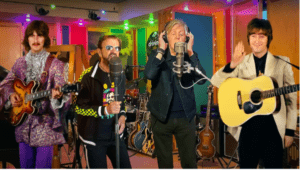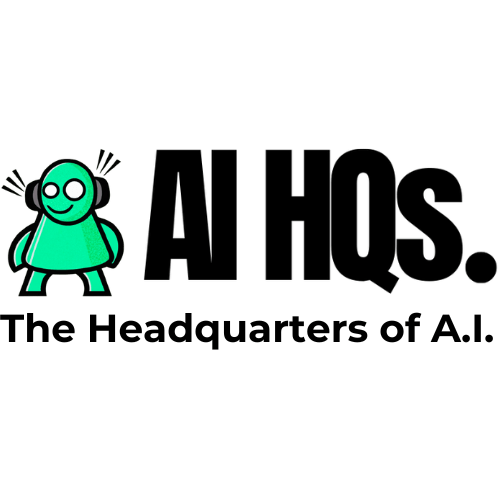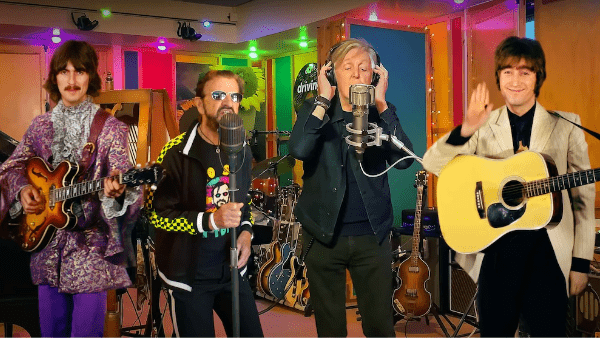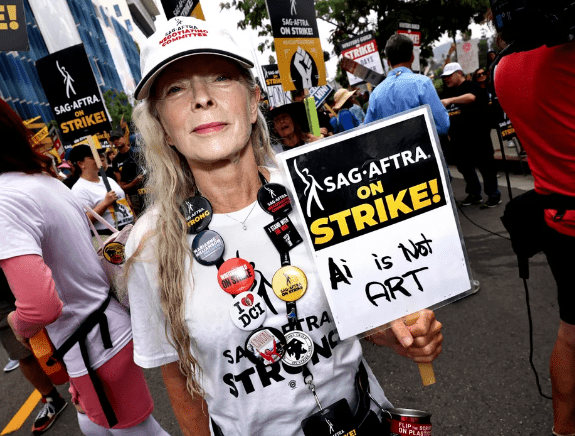Now and Then: The Beatles Nostalgia Run with AI
The iconic British rock band, The Beatles, continues to captivate the world with their music, even after more than five decades since their break-up. In a surprising twist, the Beatles are set to release their “final” song, “Now and Then,” featuring all four original members, thanks to the remarkable advancements in artificial intelligence (AI) technology. This exciting development marks a unique intersection of music history, technology, and creative ingenuity.

“Now and Then” is a song written and sung by John Lennon in the late 1970s, and it was preserved on a cassette labelled “For Paul,” along with demos for “Free As a Bird” and “Real Love.” While the latter two songs were eventually completed and released by McCartney, Ringo Starr, and George Harrison as part of the Beatles Anthology project, technological limitations had long prevented the completion of “Now and Then.” Lennon’s vocals and piano on the original recording couldn’t be effectively separated for integration with new parts recorded by the surviving members.
The Role of AI in the Beatles’ Legacy:
The breakthrough in reviving “Now and Then” came through the innovative use of AI technology. Director Peter Jackson, known for his work on “The Lord of the Rings,” employed AI-assisted software to de-mix the original audio from the Beatles’ recording sessions for their final album, “Let It Be,” in 1970. This process allowed for the isolation of instruments, vocals, and even conversations, ultimately leading to the creation of the “Get Back” documentary series.
Building on the success of AI-enhanced audio in the documentary, AI technology was subsequently used to produce a new mix of the classic album “Revolver” in 2022. This inspired Paul McCartney and Ringo Starr to revisit Lennon’s “Now and Then” demo. With the aid of Jackson and a sound team led by Emile de la Rey, they used the same AI techniques to extract Lennon’s original vocal performance from his piano.
Ringo Starr expressed the profound impact of this process, saying, “It was the closest we’ll ever come to having him back in the room so it was very emotional for all of us. It was like John was there, you know. It’s far out.” The surviving Beatles members, McCartney and Starr, played an active role in completing the song. George Harrison’s guitar parts from 1995 and a new string arrangement written by McCartney, Giles Martin, and Ben Foster were incorporated, breathing new life into the long-dormant composition. Moreover, backing vocals from the original recordings of Beatles classics such as “Here, There and Everywhere,” “Eleanor Rigby,” and “Because” were woven into the new song, creating a harmonious blend of past and present. Renowned musician Jeff Lynne also made a significant contribution to the production.
Paul McCartney’s initial remarks about AI sparked speculation and concerns, leading to the need for clarification. McCartney emphasised that nothing in the song had been artificially or synthetically created; instead, the technology was used to clean up existing recordings, a process that has been ongoing for years. McCartney’s reassurance underscored the authenticity of the Beatles’ final creation. The world will get a sneak peek into the making of “Now and Then” through a 13-minute documentary premiering on November 1, followed by the full release of the song on November 2. On November 3, it will be launched as a double A-side single alongside the Beatles’ debut 1962 single, “Love Me Do,” featuring captivating cover art by renowned pop artist Ed Ruscha.
A Quarter-Century in the Making:
The existence of “Now and Then” has long been known to fans, with Paul McCartney revealing in 1997 that it had been shelved primarily because George Harrison did not favor the song. The democratic nature of the Beatles’ decision-making process meant that even a beautiful verse and John Lennon’s vocals couldn’t save it. George Harrison had infamously labelled Lennon’s demo as “f***ing rubbish.” More recently, Olivia Harrison, George’s widow, revealed that technical issues with the original demo had hindered its completion back in 1995.
The making of the song holds a deeply emotional significance for the Lennon and Harrison families. Olivia Harrison expressed that if George were alive today, he would have eagerly joined Paul and Ringo in finishing “Now and Then.” John Lennon’s son, Sean Ono Lennon, described the experience as incredibly touching and a testament to the enduring legacy of the Beatles. It represents the last song that his father, along with Paul, George, and Ringo, got to create together, effectively acting as a time capsule from the past. The release of “Now and Then” comes ahead of new editions of the Beatles’ iconic compilations, the “Red Album” and the “Blue Album.” These expanded editions now encompass the Beatles’ entire singles discography, adding 12 songs to the “Red Album” and nine to the “Blue Album.”
The Expanding Role of AI in Music:
The Beatles’ AI-assisted revival of “Now and Then” is part of a larger trend in the music industry where AI technology is increasingly being integrated into the creative process. The potential of AI in music ranges from enhancing audio quality to assisting in songwriting and even simulating the voices of famous artists. While these developments are met with mixed reactions, they undeniably mark a significant shift in the way music is created, enjoyed, and preserved.
AI in Music – Beyond the Beatles:
The use of AI in music extends far beyond the Beatles. AI technology has been used to generate songs and simulate the voices of popular artists like Drake and the Weeknd. This has triggered debates about the authenticity and ethical implications of such AI-generated music. Some artists have embraced AI as a tool for creativity, envisioning a future where artists can licence their voices and set usage permissions.
The Grammys and the AI Controversy:
The AI-induced song “Heart on My Sleeve” stirred controversy within the music industry. The song attempted to mimic the vocal styles of Drake and the Weeknd, leading to debates about eligibility for prestigious awards like the Grammys. The music industry faces the challenge of adapting to the new possibilities that AI technology offers while addressing concerns about originality, licensing, and artistic control. The intersection of AI and music opens up new possibilities for creativity, quality enhancement, and accessibility. However, it also raises complex questions about the role of technology in artistic expression and the ethical considerations surrounding AI-generated content. While some musicians remain cautious, others see AI as a tool that can coexist with human creativity and bring new dimensions to the art of music.
Conclusion:
The Beatles’ “Now and Then” serves as a symbol of music’s evolving landscape, where AI technology is increasingly becoming an integral part of the creative process. The song’s revival demonstrates the profound impact of AI in preserving and revitalising musical legacies, while also raising questions about the boundaries of AI’s role in music creation. As we journey into this AI-infused era of music, the conversation about the intersection of technology, creativity, and authenticity in the art form will continue to evolve, challenging us


